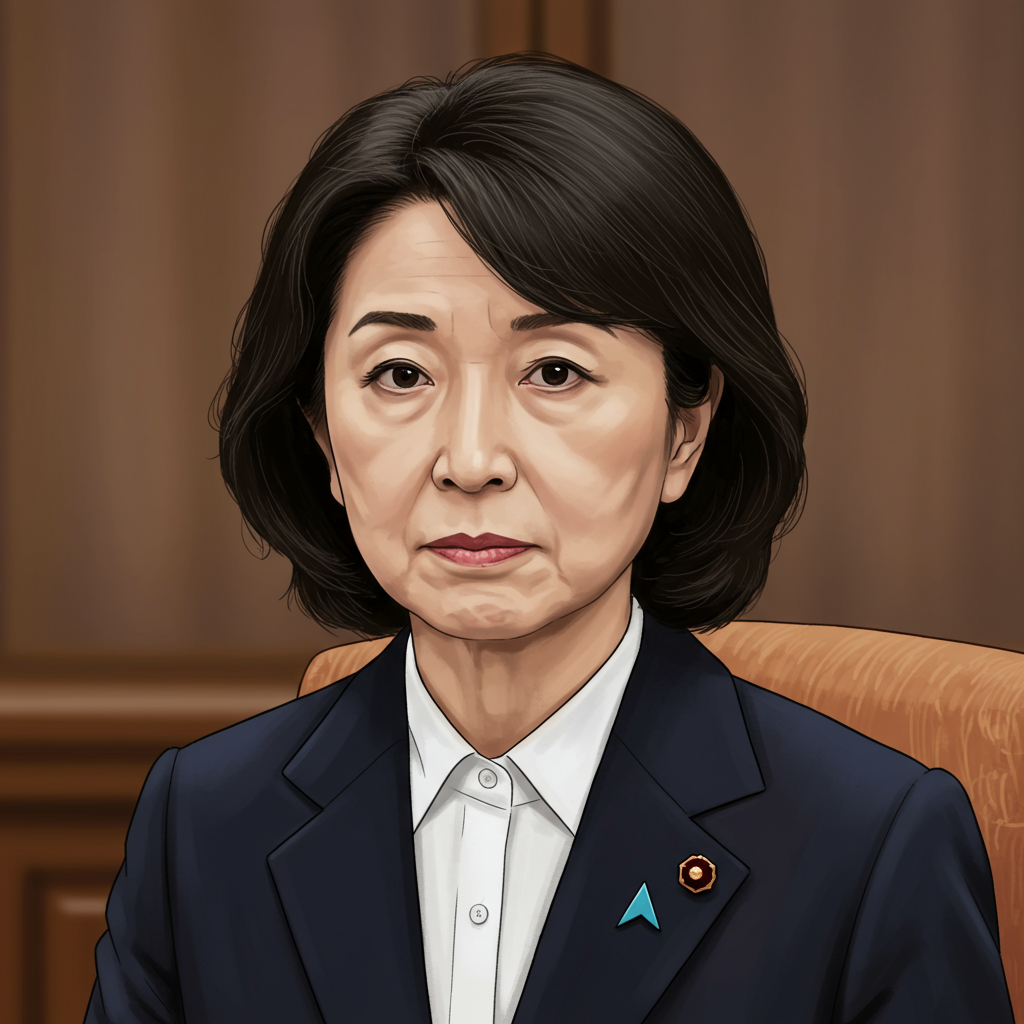Japan stands at the precipice of a historic moment as Sanae Takaichi, a staunch conservative often dubbed Japan’s “Iron Lady,” prepares to potentially become the nation’s first female Prime Minister. Her recent triumph in leading the ruling Liberal Democratic Party (LDP) marks a significant milestone. This veteran politician’s ascension comes at a critical juncture, with Japan grappling with a sluggish economy, dwindling birth rates, and an increasingly complex geopolitical landscape. Understanding Takaichi’s unique background, unwavering convictions, and strategic policy shifts is crucial to comprehending the direction Japan may take under her leadership.
The Unconventional Journey of a Political Force
Born in Nara Prefecture in 1961, Sanae Takaichi’s early life offered little hint of a future in national politics. Far removed from the traditional political establishment, her formative years were remarkably diverse and adventurous. She was an avid heavy metal drummer, known for her intense playing style that often led to broken sticks. Beyond music, Takaichi pursued scuba diving and harbored a deep passion for cars; her beloved Toyota Supra is now a museum exhibit in Nara. She also spent a brief period as a television host, demonstrating an early aptitude for public engagement.
Her political awakening stemmed from the intense US-Japan trade friction of the 1980s. Determined to grasp American perspectives, she worked in the office of US Congresswoman Patricia Schroeder, a vocal critic of Japan. This experience profoundly shaped Takaichi’s nationalist views. She observed a concerning tendency for Americans to conflate Japanese, Chinese, and Korean cultures. This led to her firm conviction: “Unless Japan can defend itself, its fate will always be at the mercy of shallow US opinion.”
A Decade of Political Persistence and Conservative Steadfastness
Sanae Takaichi’s entry into formal politics was not without its challenges. She ran unsuccessfully as an independent in 1992. However, her persistence paid off a year later when she secured a parliamentary seat. She officially joined the Liberal Democratic Party (LDP) in 1996. Since then, Takaichi has been elected as an MP an impressive ten times, losing only once. This consistent electoral success cemented her reputation as one of the LDP’s most outspoken conservative voices.
Throughout her career, she has held significant government portfolios, demonstrating her deep policy expertise. These roles include Minister for Economic Security, State Minister for Trade and Industry, and a record-breaking tenure as Minister for Internal Affairs and Communications. A close protégé of the late Prime Minister Shinzo Abe, Takaichi aligns strongly with his conservative vision for Japan. She publicly committed to reviving his “Abenomics” economic strategy, which emphasized high public spending and cheap borrowing to stimulate growth. Her dedication to Abe’s legacy underscores her right-wing credentials within the LDP.
Core Ideologies and Shifting Stances
Takaichi is a staunch conservative. She has historically opposed legislation allowing married women to retain their maiden names, arguing it undermines tradition. She also stands against same-sex marriage. On matters of national security, she advocates for easing constitutional restrictions on Japan’s Self-Defence Forces, aiming to grant them offensive capabilities. Her regular visits to the controversial Yasukuni Shrine, which honors Japan’s war dead including convicted war criminals, are a consistent feature of her public profile and often draw criticism from neighboring countries.
However, her recent campaign witnessed a strategic softening of her tone on certain domestic issues. She vowed to make babysitter fees partially tax-deductible. She also proposed corporate tax breaks for companies providing in-house childcare services. These policy shifts are deeply rooted in her personal experiences, having navigated nursing and caregiving responsibilities three times in her life. This background strengthens her resolve to expand women’s health services, enhance recognition for household support workers, and improve care options for Japan’s aging population. Takaichi declared, “I want to create a society where people don’t have to give up their careers.”
Navigating Japan’s Pressing Domestic Challenges
Sanae Takaichi’s potential premiership begins at a turbulent time for Japan. The LDP, which has largely dominated Japanese politics since 1955, is struggling to regain public trust following recent scandals. The party has lost its majority in both houses of parliament, necessitating Takaichi to lead a “fractious coalition.” This challenging political landscape is compounded by deep-seated national issues. Japan faces a persistent sluggish economy and a severe demographic decline, marked by low birth rates and a rapidly aging society.
Takaichi’s election, as a figure from the LDP’s right-wing, reflects the party’s attempt to win back conservative voters. Many traditional LDP supporters have gravitated towards the far-right Sanseito party, which campaigns on a “Japanese First” slogan and has seen a significant surge in seats. Takaichi herself acknowledged this internal challenge, stating the LDP had received “particularly harsh criticism from our core supporters.” She pledged that “The LDP must change for the sake of Japan’s present and future,” promising to always prioritize the national interest.
Immigration, Identity, and Economic Policy
The issue of immigration has become a significant talking point in Japanese politics, especially with growing concerns about over-tourism and demographic decline. Takaichi’s campaign notably featured anti-immigrant rhetoric. She made unsubstantiated claims about foreign tourists harming Nara deer, stating they “deliberately try to harm the things Japanese people treasure.” While critics called this xenophobic, such a tough stance on immigration resonated with some segments of the electorate.
Economically, Takaichi’s proposal to revive Abenomics, focusing on high fiscal spending, tax cuts, and cheap borrowing, aims to address Japan’s long-term economic challenges. However, the efficacy of these policies in the current climate, especially with Japan’s national debt, remains a subject of debate. Her personal philosophy of “work, work, work,” famously stating she would “abandon the word ‘work-life balance’,” highlights her intense dedication but also raises concerns about her approach to societal well-being.
Japan on the Global Stage: Geopolitical Crossroads
Takaichi’s leadership will profoundly impact Japan’s foreign relations. She holds a notably hardline stance on China, a position that could put her on a “collision course” with Beijing. Her historical revisionist views and consistent visits to the Yasukuni Shrine are sources of ongoing tension with both China and South Korea. Despite recent efforts to warm relations, concerns persist in Seoul regarding her firm stance against war reparations.
Conversely, her strong association with Shinzo Abe suggests a continued positive trajectory for India-Japan bilateral ties. Abe’s tenures saw significant improvements in cooperation across various sectors, including technology and critical mineral processing. India likely hopes for Takaichi to provide strong leadership in Tokyo, contributing to stability amidst regional geopolitical turbulence. Her advocacy for a stronger military and potential changes to Japan’s pacifist constitution also signal a more assertive role for Japan in regional security, potentially including a more robust engagement within the Quad framework.
Challenges and Opportunities for Japan’s First Female Leader
Sanae Takaichi’s path to becoming Japan’s first female Prime Minister is historic, yet fraught with challenges. She must unite a divided party, contend with a strong opposition, and tackle fundamental economic and demographic issues. The “Iron Lady” comparison to Margaret Thatcher sets a high bar, especially in uniting both government and party. Takaichi is seen by some as a polarizing politician, and her tenure as an ultra-nationalist leader within a male-dominated party raises questions about its impact on the feminist movement in Japan. While she has promised to increase the number of female ministers, her conservative social views on issues like married women’s surnames and female imperial succession often contradict more progressive agendas.
However, her unique blend of conservative principles, personal experiences in caregiving, and strategic political maneuvering presents unique opportunities. Her emphasis on women’s health and childcare could address critical societal needs. Her populist rhetoric on immigration resonates with a segment of the population expressing anxieties about societal changes. Ultimately, Takaichi’s success will hinge on her ability to translate her strong convictions into effective governance, addressing the daily anxieties of Japanese citizens while navigating complex domestic and international waters. The world watches keenly as Japan potentially ushers in a new era of leadership.
Frequently Asked Questions
What specific challenges does Sanae Takaichi face as Japan’s potential Prime Minister?
Sanae Takaichi inherits a daunting array of challenges. Domestically, she must lead a “fractious coalition” as the LDP has lost its parliamentary majority, requiring skillful engagement with opposition parties. She also faces widespread public frustration over a sluggish economy, record demographic decline (low birth rates and an aging society), and the rising influence of the far-right Sanseito party. Geopolitically, her hardline stance on China and historical revisionist views could complicate relations with Beijing and Seoul, while she also needs to navigate the broader global landscape and maintain strong alliances.
How did Sanae Takaichi’s early experiences shape her political views?
Sanae Takaichi’s early experiences profoundly influenced her political trajectory. Her initial exposure to politics during the US-Japan trade friction of the 1980s, particularly working in Congresswoman Patricia Schroeder’s office, sparked her nationalist sentiment. Observing American perceptions of Japan led her to conclude Japan needed stronger self-defense. Her diverse personal background as a heavy metal drummer, car enthusiast, and TV host also suggests a tenacity and unconventional approach, which she brings to her conservative political style.
What are Sanae Takaichi’s key policy priorities for Japan’s future?
Sanae Takaichi’s policy priorities are deeply rooted in her conservative ideology and personal experiences. Economically, she plans to revive Shinzo Abe’s “Abenomics” with high public spending and cheap borrowing. On national security, she advocates for easing constitutional restrictions on the Self-Defence Forces. Socially, while a staunch conservative on issues like married surnames and same-sex marriage, her recent campaign emphasized policies influenced by her caregiving experiences, such as partially tax-deductible babysitter fees, corporate tax breaks for in-house childcare, and improved women’s health services.




